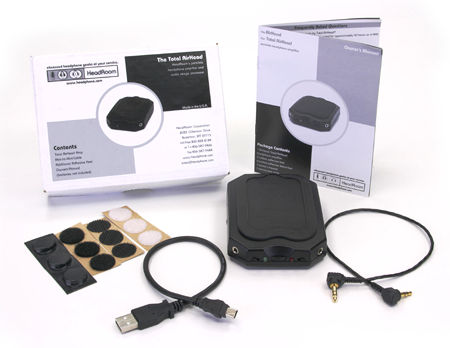| Columns Retired Columns & Blogs |
HeadRoom Total BitHead headphone amplifier
When, on his long-running TV variety show, Jackie Gleason used to order up some "traveling music" from music director Ray Bloch, he got a live orchestra's worth. But when Gleason, a composer and conductor in his own right (he wrote his show's unforgettable theme song, "Melancholy Serenade"), actually traveled, his listening options were severely limited compared to ours. By the time the comedian died in 1987, Sony had introduced the Walkman cassette player, but Apple's iPod was still more than a decade in the future.

No one will accuse HeadRoom's new Total BitHead headphone amplifier of being stylish or of riding the iPod craze, though it does make an ideal companion for an iPod. If a direct tie to the iPod was the idea, the BitHead would be shiny, sleekly curvaceous, and white, with iPod-like electronic controls and an iPod-like name. The BitHead's controls are decidedly old-school: a knurled analog volume knob and a pair of slide switches.
Like most audiophile products, the Total BitHead is about good sound, not good looks. Of course, many good-sounding products also look good. They're also more expensive. But by concentrating on sound rather than style, HeadRoom can bring you the Total BitHead for the very reasonable price of $269 (a standard model, which uses parts of lower sonic quality, costs $199).
The Total BitHead is a black plastic box that weighs just 5.5oz with its four AAA batteries. Its clunky design makes it look bigger than it actually is—set it next to a standard-size iPod and you'll see that they're almost the same size. The BitHead has two 1/8" headphone jacks.
Inside is a headphone amplifier based on Burr-Brown OPA4743 quad op-amp chips. Input can either be analog, accessible via a 1/8" stereo mini-jack, or digital through a USB port, which feeds an onboard D/A converter (a Burr-Brown PCM2902). When you're on the go with a portable MP3, CD, or cassette player, the analog connection is your only choice. But if you're accessing audio from your laptop, the USB connection is theoretically better—it takes the audio conversion out of the "dirty" computer environment and powers the amplifier, thus saving the Total BitHead's batteries.
Access to the batteries is via a large rubber flap atop the unit. The prominence and convenience of access initially led me to believe I'd be changing batteries often, but HeadRoom's projected battery life of 40 hours per set appears to be, if anything, conservative: I'm still on my first set, with which I've made round trips to Canada, Indianapolis, and twice to Europe, as well as often using the BitHead at the gym and the pool. Battery life depends on what headphones you use. What's more, using the BitHead instead of plugging headphones directly into my iPod has had a noticeable effect on the Apple's battery life—a six-hour transatlantic flight leaves the iPod with plenty of juice to spare.
Using the Total BitHead
HeadRoom supplies a short 1/8"-stereo-to-1/8"-stereo cable, a USB connector, rubber feet, and lots of Velcro Velcoin discs so you can attach your iPod or other player to the BitHead, and the BitHead to your laptop or the underside of your desk.
To use the Total BitHead with an iPod, plug the iPod's remote into the iPod, and the supplied jumper between the iPod's remote and the BitHead's input jack. A fixed level-line output would be a better interface for the BitHead, but my original iPod isn't so equipped, so I settled on setting the iPod's volume control near the top of its range, which not only sounded best but is HeadRoom's suggested setting. But be sure to turn the iPod's volume control all the way down when you power up the Total BitHead, or you'll hear a loud pop through the headphones.
A green LED glows when the BitHead's power is on. On the other side of the volume control is a red LED that lets you know when the amplifier is clipping or when the batteries need replacing. Next to that is a switch to activate HeadRoom's proprietary processing, which is designed to create a virtual room in your head instead of the usual headphone affliction of distinct blobs of sound, caused by the total isolation between channels. The processing creates interchannel cross-feeding accompanied by a small time delay, to create a smoother, more natural soundfield. The effect is subtle but useful, especially during long listening sessions, where it cuts down on fatigue—particularly with hard-panned pop recordings.
To use the Total BitHead with a computer, connect it via the USB ports and turn the BitHead off so it can be powered by the computer and save the batteries. For sound output, Mac OS X users need only go into the Finder's System Preferences menu, click on Sound, and then on USB. I don't do Windows, but I'm sure it's more complicated (send those angry letters!). HeadRoom claims that PCs "should automatically" recognize the BitHead and configure it as the default device, but I've heard the screams coming from my wife's PC-equipped home office.
- Log in or register to post comments




































